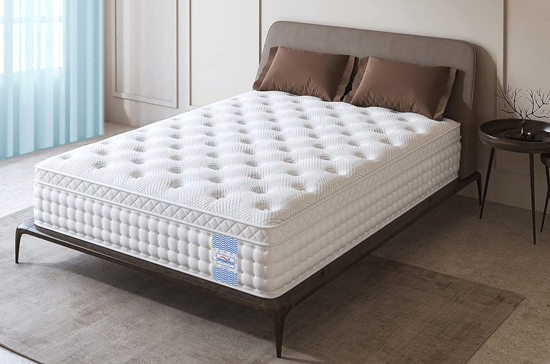Buying a mattress used to mean wandering around a store, lying down awkwardly on different beds while a salesperson hovered nearby, and trying to imagine what eight hours of sleep might feel like in two minutes. But these days, things have changed. Thanks to the internet, you can explore dozens of options from the comfort of your couch. The real challenge now? Figuring out which mattress online is actually the best for you—especially when you can’t try it in person.
The secret lies in understanding your sleeping style and matching it with the right mattress features. Because the truth is, the “best” mattress isn’t the same for everyone. It’s the one that supports your body, your habits, and your comfort preferences. Let’s break it down.
Step 1: Know Your Sleeping Position
The way you sleep plays a huge role in deciding the firmness, material, and thickness you need.
1. Side Sleepers
If you spend most of the night on your side, your shoulders and hips press into the mattress more than other body parts. You need something soft enough to cushion those pressure points but firm enough to keep your spine aligned. A medium-soft memory foam mattress is usually ideal—it contours to your body while still offering support.
2. Back Sleepers
Back sleepers need a balance between softness and firmness. A mattress that’s too soft can cause your lower back to sink, while one that’s too firm can put unnecessary pressure on your spine. A medium-firm mattress is generally the sweet spot here. Hybrid mattresses (a mix of foam and springs) often work well for this sleeping style.
3. Stomach Sleepers
If you sleep on your stomach, you need a firmer mattress to keep your hips from sinking too much. Otherwise, you risk waking up with a sore lower back. Look for a firm foam or spring mattress that keeps your body supported from head to toe.
4. Combination Sleepers
If you toss and turn, switching positions through the night, you need something versatile—a medium-firm mattress with good responsiveness so you don’t feel “stuck” in one spot. Latex mattresses or responsive hybrids are great options.
Step 2: Understand Mattress Types
When browsing for a mattress online, you’ll notice different materials and builds. Here’s a quick guide to the most common ones:
-
Memory Foam: Offers body-hugging comfort, excellent motion isolation, and is great for pressure relief. Perfect for side and back sleepers.
-
Innerspring: Traditional design with bouncy coils. Provides good airflow and firm support, making it ideal for stomach sleepers or those who like a more “on top” feel.
-
Latex: Naturally resilient, eco-friendly, and responsive. Great for combination sleepers and those who want durability.
-
Hybrid: Combines foam layers with springs for balanced support and comfort—often a safe choice for most sleeping styles.
Step 3: Choose the Right Firmness
Firmness is usually rated on a scale from 1 (very soft) to 10 (very firm). While personal preference matters, your sleeping style and body weight should guide you:
-
Soft (1–4): Best for side sleepers under 60 kg.
-
Medium (5–6): Works for most back sleepers and combination sleepers.
-
Firm (7–9): Ideal for stomach sleepers or heavier individuals who need extra support.
Step 4: Factor in Your Body Weight
This is something many people overlook when shopping for a mattress online.
-
Lighter sleepers (under 60 kg) may prefer softer mattresses so they can sink in slightly for comfort.
-
Average-weight sleepers (60–100 kg) usually do best with medium firmness.
-
Heavier sleepers (above 100 kg) often need firmer support to prevent sagging and maintain proper spinal alignment.
Step 5: Consider Special Features
Shopping online means you have access to a variety of features that might not be available in every store:
-
Motion Isolation: Perfect for couples—minimises movement transfer so you don’t feel every toss and turn.
-
Edge Support: Helps you sit or sleep near the edge without feeling like you’ll roll off.
-
Cooling Technology: Gel-infused foam or breathable covers help prevent overheating during the night.
-
Adjustable Firmness: Some online mattresses let you zip open the cover and swap layers to change firmness levels.
Step 6: Read Reviews (But Wisely)
When you’re buying a mattress online, customer reviews can be gold—just remember to take them with a pinch of salt. Look for patterns in feedback. If multiple people mention “too soft” or “great for side sleeping,” that’s worth noting. Pay attention to verified purchases for more reliable insights.
Step 7: Don’t Forget the Trial Period
One of the perks of buying a mattress online is that most brands offer a trial period—anywhere from 30 to 365 nights. This means you can actually sleep on it for weeks before deciding if it’s right for you. Make sure you understand the return policy before purchasing, just in case it’s not the perfect match.
Step 8: Budget Smartly
Mattress prices online can vary wildly—from budget-friendly to luxury models. While it’s tempting to grab the cheapest option, remember that a mattress is an investment in your health and comfort. Set a realistic budget that balances quality and affordability. Often, mid-range mattresses offer the best combination of durability and comfort without breaking the bank.
Step 9: Match Your Sleeping Style with the Right Choice
Here’s a quick reference:
-
Side Sleeper: Medium-soft memory foam or hybrid.
-
Back Sleeper: Medium-firm hybrid or foam.
-
Stomach Sleeper: Firm foam or innerspring.
-
Combination Sleeper: Medium-firm latex or hybrid.
Final Thoughts
Choosing the best mattress online isn’t about picking the most expensive one or the one with the fanciest name—it’s about matching your sleeping style, body type, and comfort needs. When you understand how these factors work together, you’ll have a much better chance of finding the mattress that helps you wake up refreshed and pain-relief.
Because at the end of the day, a good mattress isn’t just about sleeping—it’s about living better.
